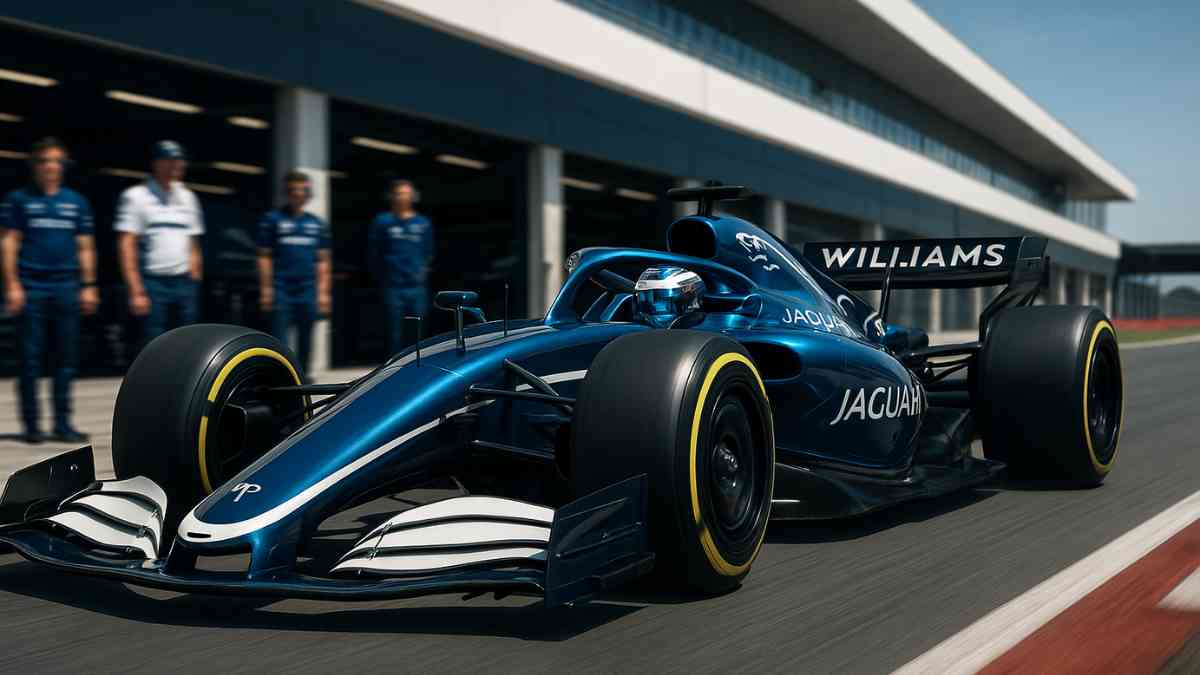Williams Jaguar: The Fusion of Motorsport Heritage and Futuristic Innovation

The name “Williams Jaguar” instantly conjures images of high-speed performance, British engineering mastery, and motorsport glory. Although the phrase may not currently represent a formal alliance in Formula One, it resonates with two of the most iconic brands in the automotive and racing world. Williams Racing and Jaguar have, independently and jointly, shaped the course of automotive innovation and motorsport excellence. This article delves deep into the intertwined history, speculative designs, real-world collaborations, and the promising future that makes “Williams Jaguar” more than just a dream for motorsport enthusiasts.
The Legacy of Williams Racing
Founded in 1977 by Sir Frank Williams and Patrick Head, Williams Racing has long been a cornerstone of Formula One. With nine Constructors’ Championships and seven Drivers’ Championships, Williams has consistently demonstrated the capability to deliver cutting-edge performance on the track. The team has played host to legendary drivers such as Nigel Mansell, Alain Prost, Damon Hill, and Jacques Villeneuve. Williams’ ethos has always been rooted in independence, engineering excellence, and a fiercely competitive spirit.
Despite recent challenges, including financial struggles and declining performance in the early 2020s, Williams has undergone a significant transformation. With new ownership under Dorilton Capital and a focus on data-driven engineering, the team has begun its resurgence. The name still carries enormous weight in the paddock, representing the pinnacle of British motorsport legacy.
Jaguar’s Evolution in Motorsport
Jaguar’s connection to motorsport dates back to the 1950s with its dominance at Le Mans. The legendary C-Type and D-Type earned multiple victories, cementing Jaguar’s position as a serious contender. In the late 1990s and early 2000s, Jaguar entered Formula One after acquiring Stewart Grand Prix, though the stint was relatively short-lived. By 2004, the team was sold to Red Bull Racing, which would go on to dominate the sport in subsequent years.
However, Jaguar never truly left the racing world. Instead, the company shifted focus toward Formula E with the creation of Jaguar Racing. Competing in the electric single-seater series, Jaguar TCS Racing has become one of the premier teams, clinching podiums and winning the 2023–2024 Teams’ Championship. Their participation in Formula E reflects a strategic shift toward sustainability and innovation, consistent with the global transition toward electric mobility.
Williams Advanced Engineering: The Common Link
While Williams Racing and Jaguar might not compete together under one Formula One banner, their paths have crossed significantly through Williams Advanced Engineering (WAE). A spin-off from Williams F1, WAE has become a hub for applied technology, particularly in electrification and energy storage.
One of the most notable collaborations was the development of the Jaguar C-X75. This hybrid supercar, although never released commercially, served as a showcase for future technologies. Williams Advanced Engineering provided the battery systems and played a pivotal role in its design and performance simulation. The C-X75 was even featured in the James Bond film “Spectre,” further cementing its place in modern automotive folklore.
Furthermore, WAE has supplied battery technology for the Formula E series, including to Jaguar Racing, thereby creating a behind-the-scenes partnership that has real implications for both brands’ futures.
Fan Concepts: The Imagined Williams Jaguar F1 Team
Across online platforms such as Reddit and Twitter, fans have envisioned what a “Williams Jaguar” Formula One team might look like. From sleek car liveries in Jaguar’s iconic British Racing Green to hybrid designs incorporating Williams’ traditional blue and white, these concepts are a testament to how passionately followers of the sport view this hypothetical union.
While currently fictional, such speculation isn’t baseless. In an age where manufacturers and racing teams are exploring new commercial partnerships, mergers, and branding collaborations, the door is never entirely closed. The imagined “Williams Jaguar” could represent a powerful marketing alignment that draws from Jaguar’s technological aspirations and Williams’ racing heritage.
The Real-World Significance: More Than Just Fantasy
Beyond fan fiction and concept art, the collaboration between Williams and Jaguar through WAE is a grounded, functional reality. Their work together reflects broader industry trends, where F1-level engineering is increasingly applied to consumer vehicles and sustainable transport solutions.
For Jaguar, the transition to electric mobility is vital. With plans to become an all-electric brand by 2025, partnerships with engineering experts like WAE are critical to achieving performance and reliability targets. For Williams, diversifying beyond F1 has proven wise. WAE’s involvement in sectors such as aerospace, defence, and now mainstream automotive demonstrates how F1 technologies influence broader technological ecosystems.
Jaguar’s Electric Ambitions and the Role of Williams
Jaguar Land Rover’s “Reimagine” strategy places the Jaguar brand firmly in the premium electric segment. The company aims to blend luxury with zero-emission technology, positioning itself against the likes of Tesla, BMW, and Mercedes-Benz in the race for electric dominance.
To this end, battery efficiency, lightweight materials, and aerodynamics are paramount. These are areas where Williams Advanced Engineering excels. With decades of data from the most rigorous motorsport environment, WAE offers solutions that reduce weight while improving energy storage and output—crucial for electric vehicle development.
Whether through direct consultancy, component supply, or collaborative R&D, the relationship between Jaguar and Williams has genuine commercial and technological implications that stretch well beyond the race track.
Williams Jaguar Manchester: A Tangible Connection
In the retail world, the name “Williams Jaguar” does in fact exist—not as a Formula One team but as a prestigious Jaguar dealership located in Manchester. Part of the wider Williams Group, this dealership embodies the spirit of both brands. It represents luxury, innovation, and customer service excellence.
While not connected to Williams Racing or WAE, the shared name further fuels the public’s association of the two brands. The dealership offers a full range of Jaguar models, from the all-electric I-PACE to the stylish F-TYPE and luxurious XF, echoing the innovation that both Jaguar and Williams represent in their respective spheres.
The Future: Could a Formal Partnership Emerge?
Given the trajectory of both brands, the idea of a formal “Williams Jaguar” Formula One partnership cannot be dismissed outright. Formula One is entering a new phase of development, with new power unit regulations set to come into play by 2026. These will emphasise sustainability, fuel efficiency, and electrification—areas in which Jaguar and Williams Advanced Engineering are already heavily invested.
If Jaguar ever decides to return to Formula One, doing so with a seasoned partner like Williams could provide a solid foundation. The logistical infrastructure, team personnel, and race data already exist; all that would be needed is the right commercial and strategic alignment. In this scenario, the name “Williams Jaguar” would move from fantasy to reality.
The Marketing Value of “Williams Jaguar”
In branding terms, combining Williams and Jaguar would be a masterstroke. Williams brings a storied past in Formula One and a reputation for technical integrity. Jaguar brings luxurious British identity and a growing reputation in the EV space. Together, the duo could create a team that appeals to traditional racing fans and environmentally conscious luxury consumers alike.
In an era where brand collaboration is key to reaching diverse markets, “Williams Jaguar” could become more than just a motorsport entity. It could represent a lifestyle brand, a technological alliance, and a cultural icon, all rolled into one.
Challenges and Considerations
Of course, any such alliance would face challenges. Brand independence, team management, funding, and long-term strategic goals would all have to align. Furthermore, both Williams and Jaguar have distinct corporate cultures and priorities, which would need careful balancing.
Another consideration is the highly competitive and financially intensive nature of Formula One. Any return by Jaguar would require a substantial commitment—not just in capital, but in long-term vision and resource allocation.
However, with the right framework and mutual goals, these obstacles are not insurmountable. The evolution of the sport itself is making such collaborations more viable, especially with the increasing focus on hybrid powertrains and sustainable racing.
Conclusion: More Than Just a Name
The term “Williams Jaguar” may currently be speculative in the world of Formula One, but it is deeply rooted in real-world achievements, shared engineering pursuits, and complementary brand values. Whether through the pioneering work of Williams Advanced Engineering or the electric future of Jaguar TCS Racing in Formula E, these two giants are already shaping the next generation of mobility.
As the boundaries between motorsport, technology, and consumer application continue to blur, “Williams Jaguar” stands as a symbol of what the future of performance, innovation, and sustainability could look like. Whether in concept or reality, the fusion of these two great names will continue to capture the imagination—and perhaps, one day soon, the starting grid.



